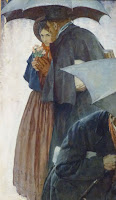Keepers of the Flame: Parrish, Wyeth, Rockwell and the Narrative
Tradition
Norman Rockwell
Museum
Stockbridge, MA
Exhibit Now Closed
I waited until this exhibit closed to review it to avoid
ruining anyone’s enjoyment. Curator Dennis Nolan's show was wonderful, but his
premise was contrived.
“Keepers of the Flame” centers on three masters: Maxfield
Parrish (1870-1966), N.C. Wyeth (1882-1945), and Norman Rockwell (1894-1978).
There is generally some artifice at the Rockwell Museum. He lived in
Stockbridge, and his namesake institution invariably puffs up the local hero in
efforts to show that he was more than an illustrator. This baffles me. Is there
anything wrong with being a great illustrator? Does one need to cast Rockwell
as an American Leonardo?
This time, though, the overreach is imperial in nature. The
three artists are the “keepers,” but the “flame” is their teachers. The concept
intrigues. I spent four decades of my life as a teacher and there is nothing I
did professionally that satisfies more than when former pupils tell me I had a
positive impact on their lives. But what the Rockwell Museum did would be the
equivalent of me tracing my own mentor line back to Socrates based on the fact
I often used the Socratic Method.
Nearly all non-folk artists have been formally trained and
their instructors deserve recognition, but the long chain constructed by Nolan
quickly falls apart. Parrish studied under painters such as Thomas Anshutz and Robert
Vonnoh, but his greatest inspirations came from mythology and fairy tales. This
was acknowledged, but does this give license to connect Parrish with every
artist from Renaissance masters to Bouguereau that drew from the same sources?
To return to a previous metaphor, I have also read Plato and took philosophy classes.
So was he too a “mentor?” That’s absurd, so why make such grandiose claims for
artists?
The rationale is that if Parrish influenced Wyeth, and Wyeth
influenced Rockwell, then Rockwell’s roots go back to the Renaissance. Except
they don’t! Wyeth owed a debt to Howard Pyle, and Rockwell to figures such as
George Bridgman and Thomas Fogarty. I doubt any of them would have claimed
their work connected to 14th century Florentine traditions in any but
the most circuitous ways. Nolan confuses converging coincidences with a Venn diagram.
Any painter, illustrator, or sculptor would have studied the same art books,
the same masterpieces, and would have taken history of art courses. Unless one is
comparable to Jackson Pollock and invents a completely new style of painting, at
some point every artist treads upon the past. This is what provides fodder for continuing
debates over whether an individual artist has breathed new life into the past,
or merely romped amidst dusty bones.
 |
| Parrish |
Although I didn’t buy the central premise for a moment, I really
liked the exhibit. It folded in works from Anshutz, Bridgman, Bouguereau,
Fogarty, Pyle, Vonnoh, Thomas Eakins, Henry Siddons Mowbray, and others. The
stars, though, are Parrish, Wyeth, and Rockwell. It was wonderful to see them
displayed in each other’s company. All drew water from the fantasy well and we
can see how each dealt with dream worlds. If there is a weak link, it is
Rockwell himself. Parrish and Wyeth dove into myth and fantasy. Rockwell mostly
just dipped in his toes.
Parrish was the most mystical. His paintings and
illustrations drew
upon retold fables and tales, but also upon a field in its
infancy when he was in his: psychology. If you are at all familiar with
Parrish—such as his commercial work for Edison-Mazda light bulbs and his
illustrations of Mother Goose stories—you have seen his use of gauzy but
luminous color that seems to have escaped from dreams begging to be analyzed.
Although their styles were quite different, Parrish works have the same feel as
those of artists such as Bertrand Redon (1846-1916) and Edvard Munch
(1863-1944).
Nature and romantic novels, Westerns, King Arthur legends
and swashbuckling tales such as Robinson Crusoe and Treasure Island inspired
N.C. Wyeth. He, like Parrish, often
favored darker hues over light colors. Unlike either Parrish or Rockwell, he painted
a lot of oils. (His other great production was siring one of America’s most
famous extended family of artists.)
 |
| Wyeth |
 |
| Wyeth |
Rockwell might be the greatest guilty pleasure in the
history of American art. His is the kind of work that self-proclaimed “serious”
critics delight in panning when
they are not secretly enjoying it. Rockwell’s
connections to Parrish and Wyeth rest most strongly on the fact that all three
did commercial illustrations and were widely reproduced in popular magazines.
As anyone can see at a glance, Rockwell’s work is much sunnier, either
literally or emotionally so. Parrish and Wyeth often look at things that arose
from the subconscious; Rockwell preferred subjects that were metaphors of American
life. Ironically, this made him the most political of the three.
Why not just say this and trust viewers to draw parallels?
By detouring down dead end side streets, Keeping
the Flame diverted attention away from the well executed, often whimsical,
and fascinating works of three fine artist/illustrators.
Rob Weir






No comments:
Post a Comment